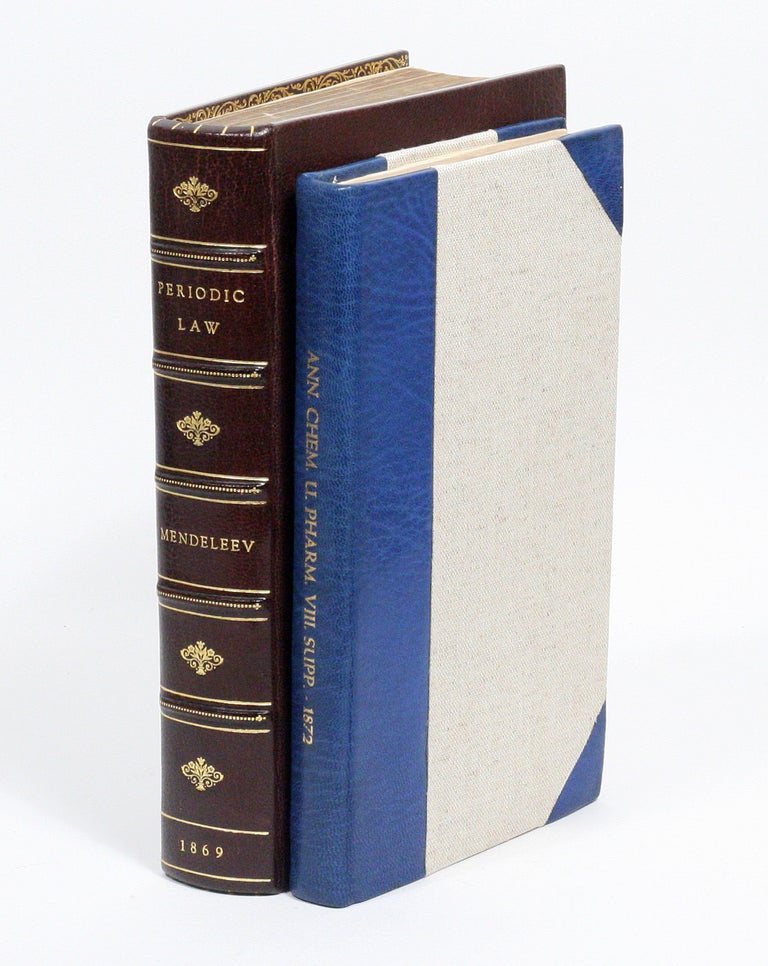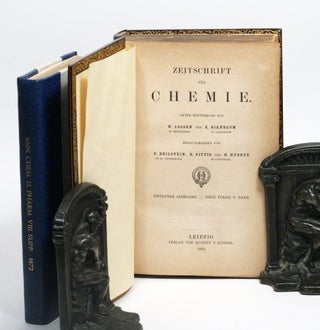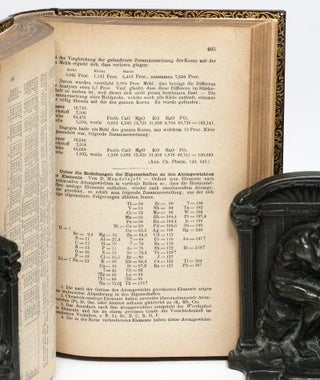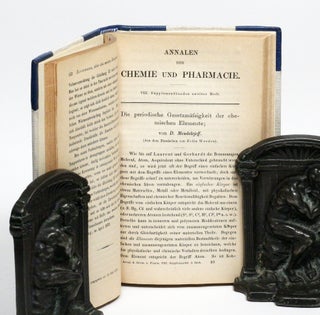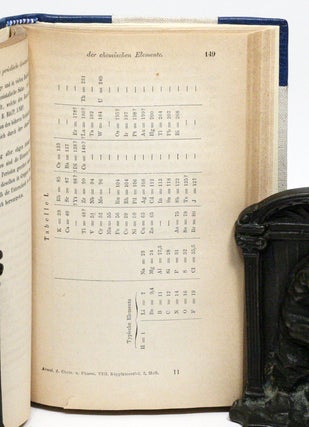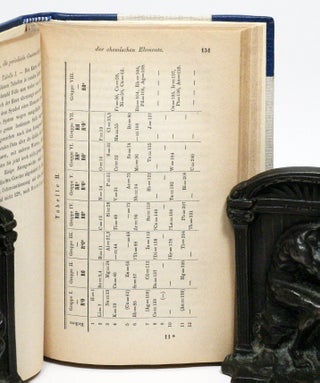Ueber die Beziehungen der Eigenschaften zu den Atomgewichten der Elemente (“On the Relationship Between the Properties and Atomic Weights of the Elements”), IN Zeitschrift für Chemie (1869); WITH: Die Periodische Gesetzmässigkeit der Chemischen Elemente (“The Periodic Law of the Chemical Elements”), IN Annalen der Chemie und Pharmacie (1871)
"As long as chemistry is studied there will be a periodic table. And even if someday we communicate with another part of the universe, we can be sure that one thing that both cultures will have in common is an ordered system of the elements that will be instantly recognizable by both intelligent life forms."
– John Emsley, The Elements; quoted in Eric R. Scerri, The Periodic Table, p. xv
"[The periodic table] is probably the most compact and meaningful compilation of knowledge that man has yet devised. The periodic table does for matter what the geological age table does for cosmic time. Its history is the story of man's great conquests in the microcosmos.
– Harlow Shapley, Of Stars and Men, pp. 38–39
INTRODUCING THE PERIODIC TABLE TO THE WESTERN WORLD: FIRST EDITIONS OF TWO KEY PAPERS RELATING TO MENDELEEV’S DISCOVERY OF THE PERIODIC LAW—ONE OF THE MOST IMPORTANT DISCOVERIES IN MODERN CHEMISTRY.
One of the most consequential scientific discoveries of the last 150 years was Dmitri Mendeleev’s realization that if the chemical elements were listed in a natural order (originally by atomic weight, and later by atomic number), then the list could be broken down into rows and displayed in the form of a table in which the elements within each column of the table had similar chemical properties. The resulting tabular display of the elements is now known as the periodic table. Mendeleev explained the ability to construct such tables in terms of a general principle that chemical properties change periodically as one moves along the ordered list of elements.
This insight had an important immediate consequence: it facilitated the identification of gaps in the list of known elements, and enabled chemists to predict the properties of the elements that would later be discovered to fill those gaps.
Even more importantly, periodicity stimulated other theoretical advances. As E.R. Scerri notes: “Whenever scientists are presented with a useful pattern or system of classification, it is only a matter of time before they begin to ask whether there may be some underlying explanation for the pattern. The periodic system is no exception.” (The Periodic Table, p. xix). Thus, the periodicity of element’s chemical properties found a natural explanation in Bohr’s 1913 proposal of a “quantum” model of the atom in which electrons were arranged in concentric “shells,” each with a characteristic fixed size. As atomic number increased, so did the number of electrons in an atom. The additional electrons were added to the outermost shell one-by-one until it was full, and then they began occupying a new outer shell. The atoms of chemically similar elements were postulated to have the same number of electrons in their outer shells. In turn, that insight led to later developments in quantum theory—such as the Pauli exclusion principle and the spin-statistics theorem—which provided an explanatory framework for, and refined, Bohr’s “shell” model.
Like all prescient discoverers, Mendeleev stood on the shoulders of giants. The organization of the elements into groups with similar properties goes back to at least the eighteenth century, and some chemists had experimented in the 1860s with tabular arrangements of elements listed in order of increasing atomic weight (see Edward G. Mazurs, Graphic Representations of the Periodic System during One Hundred Years, ch. 1). Lothar Meyer, for example, drew a periodic table in 1868 but did not publish it. It was Mendeleev, however, who in 1869 announced the periodic law as the natural principle underlying such tables:
"Mendeleev] is by far the leading discoverer of the [periodic] system. Although he was not the first to develop a periodic system, his version is the one that created the biggest impact on the scientific community at the time it was introduced and thereafter. His name is invariably and justifiably connected with the periodic system, to the same extent perhaps as Darwin’s name is synonymous with the theory of evolution and Einstein’s with the theory of relativity.
"Although it may be possible to quibble about certain priority aspects of his contributions, there is no denying that Mendeleev was also the champion of the periodic system in the literal sense of propagating the system, defending its validity, and devoting time to its elaboration." (Scerri, The Periodic Table, p. 101).
Mendeleev’s discovery was initially announced in a paper read before the Russian Chemical Society in St. Petersburg in 1869, and published the same year in the Journal of the Russian Chemical Society (Zhurnal russkago khimicheskago obshchestva). However, it is the two works offered here that put the discovery before the eyes of chemists in western Europe and America.
These works are:
1. An abstract, in German, of Mendeleev’s 1869 paper. “The German abstract, which contains a version of the periodic table, was the first announcement of Mendeleev’s discovery published in Western Europe.” (The Haskell F. Norman Library of Science and Medicine, ed. Diana H. Hook and Jeremy M. Norman, 2 vols. (San Francisco: J. Norman, 1991), 1491). The original paper “was not translated from Russian until 1895 and consequently played little or no role in initially acquainting American, British and western European chemists with the periodic law. This role was played instead by two short German abstracts of the paper, one of which appeared in the Journal für praktische Chemie and the other in the Zeitschrift für Chemie {The latter is the one offered here.} […] The first reproduced only Mendeleev’s table, without any commentary or explanation […] To the best of our knowledge, only the longer abstract in the Zeitschrift für Chemie had a significant impact, as it was the reading of this abstract that stimulated the German chemist, Lothar Meyer, to publish his own thoughts on the periodic law in late 1870 and which ultimately gave rise to a vigorous priority debate.” (William B. Jensen, “Origins of the Period Law, 1869–1871”, in Dmitri Ivanovich Mendeleev, Mendeleev on the Periodic Law: Selected Writings 1869–1905, ed. Jensen (Cincinnati: University of Cincinnati Press, 2002)).
2. The first complete and detailed presentation of the periodicity principle, and Mendeleev’s first use of the term “periodic” to describe that principle. “It was in this article that Mendeleev spelled out his detailed predictions [of the properties of as-yet unknown elements] that, when later confirmed, were to make him famous.” (Scerri, The Periodic Table, p. 112). Mendeleyev himself characterized this paper as “the best summary of my views and ideas on the periodicity of the elements and the original after which so much was written later about this system.” (Dictionary of Scientific Biography, ed. Charles Gillispie, 16 vols. (New York: Charles Scribner’s Sons, 1970–80), IX, p. 289).
The 1869 abstract is offered here in the complete twelfth volume of the journal Zeitschrift für Chemie, bound in full modern maroon morocco with gilt lettering and raised bands. Leipzig: Von Quandt & Händel, 1869. The Mendeleev paper is on pages 405-6. Very faint old institutional stamp to the general title page, mild uniform browning to the text.
The second item is offered in the “Supplementband VIII” to the journal Annalen der Chemie und Pharmacie, recently rebound in three-quarter blue half goat with gilt lettering to the spine. Leipzig und Heidelberg: C.F. Winter'sche, 1872. The Mendeleev paper is quite long, appearing on pages 133-229. Tiny closed tear in bottom margin of one table, otherwise fine.
BEAUTIFULLY BOUND COPIES OF THE TWO KEY PAPERS ANNOUNCING MENDELEEV’S “PERIODIC LAW” TO WESTERN SCIENTISTS.
References:
Dictionary of Scientific Biography, ed. Charles Gillispie, 16 vols. (New York: Charles Scribner’s Sons, 1970–80)
Emsley, John, The Elements, 3rd edn. (Oxford: Oxford University Press, 1998)
The Haskell F. Norman Library of Science and Medicine, ed. Diana H. Hook and Jeremy M. Norman, 2 vols. (San Francisco: J. Norman, 1991)
Jensen, William B., “Origins of the Period Law, 1869–1871”, in Dmitri Ivanovich Mendeleev, Mendeleev on the Periodic Law: Selected Writings 1869–1905, ed. Jensen (Cincinnati: University of Cincinnati Press, 2002)
Mazurs, Edward G., Graphic Representations of the Periodic System during One Hundred Years, 2nd edn. (Tuscaloosa: University of Alabama Press, 1974)
Scerri, Eric R., The Periodic Table: Its Story and Its Significance, 2nd edn. (Oxford: Oxford University Press, 2007)
Shapley, Harlow, Of Stars and Men: The Human Response to an Expanding Universe (Boston: Beacon Press, 1958).
Price: $8,500 .
See all items in
Science & Technology
See all items by DMITRI IVANOVICH MENDELEEV


